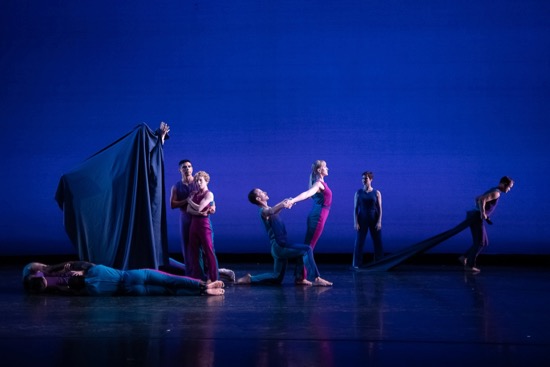
Mark Morris can be a playful fellow, and for his latest work, Sport, he collaborated with a playful musician, who was no longer living. Erik Satie wrote his Sports et Divertissements in 1914 (an unfortunate date) and published it, updated, in 1923. His original little book consisted of an introduction and the scores of twenty piano pieces under a minute in length, illustrations of each by Charles Martin, and wry, enigmatic words (think haiku that avoid an encapsulating last line) threading through the music, itself not concerned with resolving dissonances or belting finalities. If Satie’s piece were performed as written, a pianist and speaker would collaborate.
What Morris has not done is to construct a linear compendium of tiny dances, although tiny episodes certainly crop up. Nor has he provided a speaker. At Jacob’s Pillow, Colin Fowler, the Mark Morris Dance Group’s music director and pianist, rarely inserts long pauses between sections, and we never learn Satie’s titles. Instead, we see the musical ideas generated by these repeated, dissected, and set against one another by Morris for twelve of MMDG’s superb dancers, glowing in Nick Kolin’s lighting.
Here’s how Satie labeled his pieces: “Golf,” “Tennis,” “Water Chute,” “Sleighing,” “Puss in the Corner,” “Fireworks,” and so on. You can’t miss dancers swinging an invisible golf club or tennis racquet. Or scanning the sky. You’ll notice a game of blind man’s buff in which a bunch of people dodge Nicole Sabella, who’s had a blindfold tied over her eyes by Noah Vinson. You may imagine a sail when hidden dancers hold up a piece of fabric just so, or think of a playground when two guys swing Christina Sahaida high. But you may also realize how cleverly Morris is playing with these recognizable images in relation to the music. When one couple after another (man-woman, man-man, woman-woman, etc.) does an idiosyncratic ballroom dance across the front of the stage, not all are doing it to the music labeled “Endless Tango.” And at the same time, behind those partners, Dallas McMurray is being pulled along by someone (I forget who) with an invisible leash, and more dog walkers succeed that pair. Domingo Estrada, Jr. drags another performer along, and McMurray crawls after them.
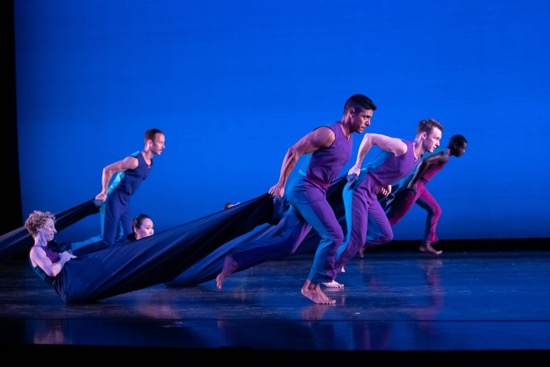
Morris plays delicious games with Satie’s variegated material. If I’m not mistaken, we’re hearing “Water Chute” when three men, supine with their legs together and their arms plastered to their sides, scootch along on their backs. But who knows or cares what piece of Satie’s Morris is referring to when someone traverses the stage holding up his or her hands crooked into hooves? In one voyage, four women loll, laughing, on “boats” (pieces of fabric) pulled across by four men. Is this “Sleighing?” Does it matter? During another such trip, the women wield unseen oars.
All the above come under the heading of Sports, but there are Divertissements too, even though Morris deleted them from the dance’s title. Occasionally the dancers will leap happily or chassé about in some “lovely” spontaneous-looking dancing. They’ll fall down and be helped up, or fall and get up by themselves. For a few brief seconds, Estrada, Jr., Brandon Cournay, and Lesley Garrison are the only threesome left standing.
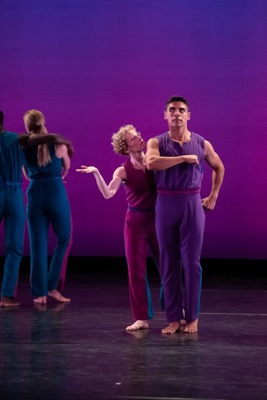
Nick Kolin’s lighting saturates the backdrop with various hues. Elizabeth Kurtzman’s jumpsuits vary in terms of color, but it’s a nice surprise when at the very end of Sport, the dancers all turn their backs to us to make one last golf swing, and everyone is green. Wait, though, that’s not the end. Noah Vinson must have missed his shot; he turns around and says, “Shit!” Then the lights go out.
As always, Morris makes sure we notice the dancers as individuals. Those I haven’t mentioned are as memorable as those I have: Mica Bernas, Brandon Randolph, and Billy Smith.
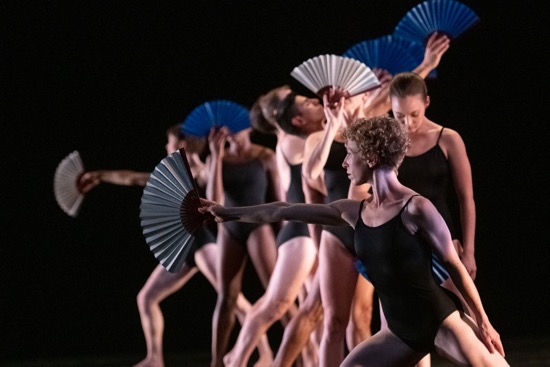
Prelude and Prelude, the earliest piece on MMDG’s Jacob’s Pillow program, dates from 1984. The music is Henry Cowell’s Set of Two for Violin and Harpsichord, played by Gregory Valtchev on violin and Fowler on piano. As with a number of earlier dances by Morris, this two-part one is structurally simple but imaginative in its details. Nine dancers dressed alike in strappy black leotards stand in a line set on a slight diagonal on one side of the stage. They all (Karlie Budge, Estrada, Jr., Garrison, Grant, Loux, Laurel Lynch, McMurray, Minga Prather, and Sabella) hold fans—blue on one side and silver on the other. Almost immediately, Loux breaks away—rolls away— from the others and begins a solo.
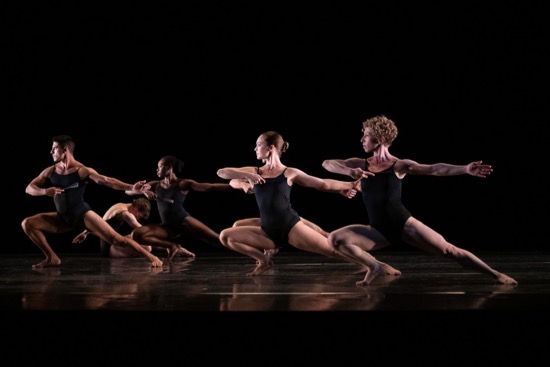
The eight people, now clustered in Jeff Pickford’s lighting, seem to have a list of ways in which to wield and turn their fans slowly and deliberately, but they may enter the sequence with a different one of the moves or perhaps even construct their sequence differently. You may see two of them doing the same gesture at the same time. Loux, meanwhile, folds his fan and holds it between his teeth. His dancing is bolder and stranger; he takes tiny little steps on tiptoe, but also takes low, wide strides or sinks into lunges. Back in 1984, as I recall, the soloist was a woman; in any case, gender plays no role in Prelude and Prelude.
The music is played twice. During the first half of the dance, I associate Loux more with the violin’s song than with the piano, but then, after a blackout, the balance shifts. The other eight move toward the center of the stage and he takes their place stage left. Now rooted to the spot, he lifts and turns and lowers his fan, holding each pose while they assume his bolder moves: the deep lunges, the curling to the floor.
Maybe it’s the fans that make me think of Japan and the contrast between approved ceremonious behavior and anxieties and enmities that tear the guts.
The next work on the program comes as something of a shock. The excerpts from Morris’s Words are drawn from Felix Mendelssohn’s many Songs Without Words, composed close to the middle of the 19th century. Valtchev and Fowler are again the musicians, and the music sings romantic melodies, erupts into windstorms, paces out a funeral march, and more.
As in India’s Kathakali dance dramas, various of the ten dancers in Morris’s 2014 Words often enter and leave stage hidden behind a large, black-bordered fabric sheet carried by two of their colleagues (we can usually see feet walking below the sheet’s bottom border). When it’s pulled aside for the first time, there stand Bernas and Smith ready to dance. These comings and goings resonate in my mind with a magician who triumphantly whips away an apparently empty cloth to reveal a rabbit.
The dancers—dressed in bright-colored tops and long shorts designed by former MMDG dancer Maile Okamura—periodically start to enter from the wings and then think better of it. You could imagine that they don’t know that part of the choreography yet, or are checking when they’re supposed to come onstage. Lynch and Randolph support each other in one of the duets; Prather and Smith like the look of that and duplicate it. In the dissimilarly textured musical pieces and the way dancers are transported on and off the stage, I get the impression of a society that doesn’t waste time on polite transitions. You don’t get up from your elegant host’s table and say goodbye and thank you. You’re swallowing your last bite of pudding as the butler carries you out the door.
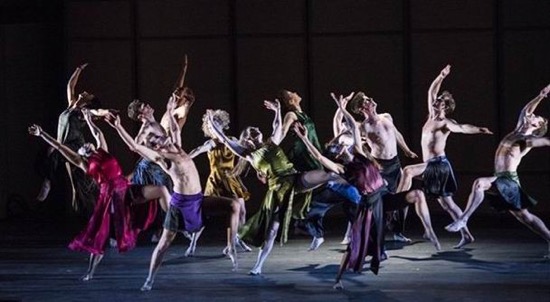
Morris, I believe, has made eight works to pieces by Lou Harrison, and he chose to end his company’s Jacob’s Pillow program with Grand Duo (1993), set to four of the five parts of Harrison’s mesmerizing Grand Duo for Violin and Piano. The sections’ names provide a clue of sorts: “Prelude,” “Stampede,” “A Round,” and “Polka.” You can envision people coming together for a very fierce folk dance. The fourteen MMDG dancers are dressed in satin, jewel-colored clothes by Susan Ruddie, but what they show you is tough from the outset. They stand facing the audience, their feet wide apart, their knees bent, and their hands flat against their hips. At the Pillow, Michael Chybowski’s lighting doesn’t create the high beam of light that I remember stretching across the stage in an earlier performance. The dancers reach up with loose-wristed hands, either feeling for it or bathing in the memory of it. But Harrison’s driving rhythms (wonderfully played by Valtchev and Fowler) call out, and they respond. They stay low, bouncing from foot to foot—slapping their hips, maintaining their places in space.
By the time they form a big circle for the final “Polka,” you’re ready to believe you’re watching a ritual that takes no prisoners. While they stamp out the rhythms and keep that bounce going, their arms are busy too—shaking, punching the space, almost as if they’re scrubbing it. For a while, they sit, but keep the beat with their heads or by kicking a leg high. On their feet again, they remake the circle and start it spinning, but an arc of them breaks away and nestles into what’s left of the circle (now frozen); then that arc rushes on while the other freezes. The splitting, minimizing, and restoring the circle is impossible to describe, fascinating to watch. These dancers are not about to stop. They recap their steps and gestures, form two criss-crossing lines, and by the time Harrison’s polka is done, they’ve been going for about four-and-a-half non-stop minutes. Are they scaring up a storm? Better take cover.

So sorry I cannot get up to the Pillow in time for this, since Morris’s work is always thought-provoking and based in real-life Movement. He has seriously also changed the expectation of what partnered and “community” dance mean. Your review tells me I must try to catch these at BAM!
Lovely writing Deborah and am ever grateful to you for taking me to the Pillow, since I’m way too far away to get there any other way.
I wish I’d seen this from your description , Deborah